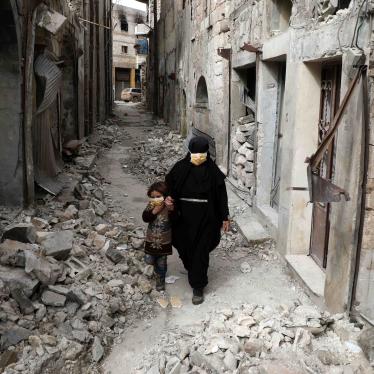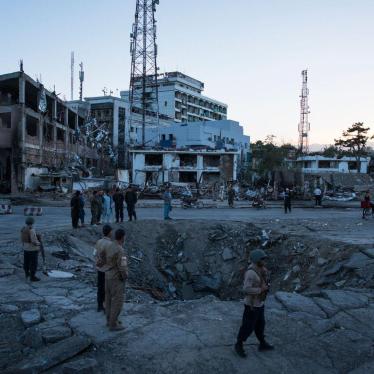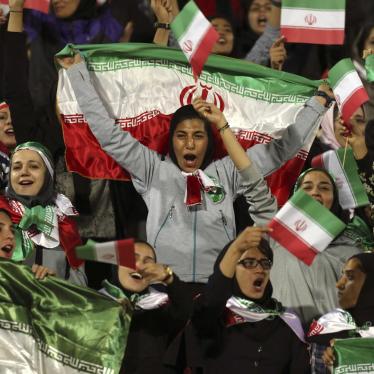In a transcript of a Pentagon Press Briefing, released this week by Airwars, n.S. Central Command’s Deputy Director for Operations made a striking admission about U.S. investigations into civilian casualties in Syria:
Q: Okay. So, you didn’t talk to anybody on the ground and nobody visited the site. Is that — that correct, right?
GEN. BONTRAGER: That is correct, Bill, and that’s common. It’s a rare thing with strikes like this that we can get on the ground in person, or that we can talk to anybody on the ground is not uncommon at all.
The admission was made as Bontrager described his investigation into the March 16, 2017 al-Jinah strike, a U.S. strike that human rights NGOs say may have killed up to 38 civilians praying at a mosque. Bontrager concluded, in contrast, that only one civilian “likely” died.
Human rights groups have long voiced concerns about the inadequacy of U.S. investigations into the consequences of U.S. strikes in Afghanistan, Iraq, Somalia, Syria, Yemen, and elsewhere, but it is rare to see such an open and general acknowledgement from the Pentagon that its investigators rarely conduct site visits or speak with witnesses and other people on the ground.
Bontrager described his investigation into the al-Jinah strike as “leaving no stone unturned.” The U.S. Director of National Intelligence has elsewhere criticized NGO research into U.S. strikes and asserted that the U.S. government uses “post-strike methodologies that have been refined and honed over the years.”
But the U.S. government’s failure to regularly interview witnesses is a critical flaw in their investigation methodology. A lack of on-the-ground networks, security concerns and/or issues related to impartiality are not insurmountable and can all be addressed if they are considered to be necessary to a robust investigation.
The U.S. government’s investigations regularly exclude one of the most important sources of evidence, and are at odds with international fact-finding best practice, developed over the past decades by researchers and investigators with human rights NGOs, the United Nations, and international criminal tribunals. It would be unthinkable in those contexts to maintain a regular practice of “investigating” human rights or humanitarian law violations without site visits where possible and without actually speaking with witnesses, victims, and family members. Interviewing is so essential that it has been described as the “bedrock” of human rights fact-finding, and every major guide to or principles for human rights fact-finding contains significant sections on witness interviewing (see here, here, here, here).
Human rights investigators have developed techniques to conduct on-the-ground investigations and witness interviews all around the world, in highly insecure and conflict areas including in Afghanistan, the Philippines, the Central African Republic, Iraq, Libya, Syria, and Yemen. Sites are visited to observe first-hand physical damage, and witnesses and survivors are interviewed to obtain essential information about what happened, how, when, and where.
Witness evidence, of course, can be flawed: eyewitnesses may have poor recall, they may be biased, they can intentionally falsify. (Meghan Foster Lynch’s chapter in the edited volume Counting Civilian Casualties (2013) and Nancy A. Comb’s Fact-Finding without Facts (2010) both include excellent overviews of the challenges in obtaining reliable and credible testimony). This is why human rights investigators need to be trained in interviewing techniques, why large numbers of people are often interviewed, and it is why researchers seek to corroborate witness statements with other sources of information, such as site visits, physical evidence, photographic evidence, medical reports, hospital records, and so on.
Bontrager said his team reviewed “all available video and images.” Many human rights groups are increasingly using satellite imagery techniques and other technologies to document human rights abuses and humanitarian law violations. But these techniques can rarely stand as a full substitute for speaking with victims and witnesses, who help provide important contextual details, resolve inconsistencies, and can shed light on people’s identities, motives, and intentions. This direct contact can also help dispel false assumptions that foreign militaries may have about unfamiliar “pattern of life” behavior. Accounts from Afghan civilians were key to coalition forces learning that it could be farmers, not Taliban fighters, who were escaping the sun by planting their crops, and not IEDs, near the road during the night.
Speaking to victims, witnesses, and other people on the ground also helps provide these investigations a degree of transparency. Without this, affected communities often criticize these investigations as being secretive and incomplete. It is similarly important for as much of the investigation results to be made public as is possible — something the Pentagon has not done in this case and which inhibits independent detailed reviews of their methods and findings. A short (closed) press briefing is deeply insufficient.
The investigation into the al-Jinah strike is a prime example of how important it is to interview witnesses. In the immediate aftermath of the attack, U.S. authorities claimed that it had struck a community hall. True, the building did not have a dome or a minaret that would indicate that it was a mosque to aerial surveillance. But multiple witness statements explaining in great detail the layout and use of the targeted building, together with photos and videos of the interior, allowed civil society organizations to conclude that the targeted building was part of a mosque, a fact that the Pentagon also had to admit after its investigation.
A thorough investigation of the al-Jinah strike could also determine, for example, how many of the people in the mosque were fighters and how many were civilians and whether the pre-strike intelligence provided a correct estimate of this. Although not the only issue to consider in determining the lawfulness of the attack, establishing such facts is nonetheless important in evaluating the reliability of the intelligence so that lessons can be learned from attacks that cause higher than expected civilian casualties. Interviewing witnesses would provide important information about who was a civilian and who was a fighter, especially if people don’t carry weapons or wear uniforms.
In some cases, NGOs and the UN face difficulties in visiting or interviewing at the sites of an alleged abuse—because of extreme insecurity, denial of access by a government or non-state actor, or concerns about retaliation to witnesses or families if they are seen with investigators. In such cases, human rights researchers have found other ways to obtain evidence. Some researchers conduct interviews in highly discrete locations or work with other researchers who can more safely meet with witnesses; witnesses are brought to other sites, interviewed in other towns or countries far away from the site of an attack; and interviews are conducted by phone or video link. The UN’s Commission of Inquiry into North Korea, for example, when North Korea denied their entry, interviewed scores of witnesses in other countries. The international criminal tribunals and the International Criminal Court have interviewed witnesses away from the immediate site of conflict.
When NGOs or the UN have not conducted site visits or interviews, governments lambast them. The U.S. government, for example, heavily criticized a 2006 report of UN Special Rapporteurs in these terms:
It is particularly unfortunate that the Special Rapporteurs rejected the invitation to visit Guantanamo. [The visit was rejected by the Special Rapporteurs after the U.S. said it would only permit a visit subject to restrictions on access, including to detainees.] As a result, their Report does not reflect the direct, personal knowledge that this visit would have provided… We categorically object to most of the Report’s content and conclusions as largely without merit and not based in the facts… [During a visit, the UN team] would have observed first-hand the conditions of detention.
The U.S. government accused the UN investigators of not doing “any meaningful investigation,” listed their failure to visit Guantanamo as the first “flaw” in the UN’s investigation, and critiqued the UN team for not speaking directly with U.S. Department of Defense officials in Washington, DC.
It is undeniable that it can be difficult for the U.S. government to speak directly with victims and witnesses to the al-Jinah strike or its other strikes in insecure locations. This does not, however, allow the government to shed its responsibilities for conducting thorough investigations where there are such serious allegations of civilian casualties and human rights abuse. International law requires governments to carry out comprehensive investigations of alleged serious human rights and humanitarian violations. Investigations into alleged unlawful deaths should be prompt, effective, thorough, independent, and transparent, and victims and families have a right to information about what occurred.
Human rights investigators have demonstrated that the hurdles are not insurmountable. The U.S. government’s failure to speak to people on the ground demolishes Bontrager’s claim that his investigation left “no stone unturned.” Human Rights Watch, in contrast, interviewed 14 people by phone who had first-hand knowledge of the attack, including four who were in the mosque at the time of the attack; eight local residents, first responders, and local journalists who arrived at the site shortly after the attack; and two medical personnel who treated people injured in the attack. Significant reforms are needed to the U.S. government’s investigations to ensure it meets its responsibilities to account for its possible violations of international legal obligations.
Note: This piece was co-authored by Sarah Knuckey, Ole Solvang, Jonathan Horowitz, and Radhya Almutawakel









